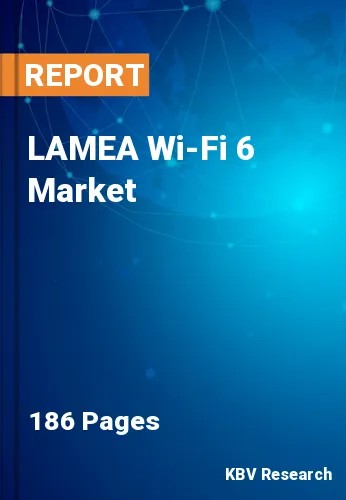The Latin America, Middle East and Africa Wi-Fi 6 Market would witness market growth of 30.1% CAGR during the forecast period (2023-2030).
Wi-Fi 6 utilize channels and sub-channels more efficiently, improving performance in settings with many connected devices. This is essential for increasing Internet of Things (IoT) devices. Wi-Fi 6 generally has a better range than preceding generations, which is due to advancements in signal encoding and modulation methods.
Target wake time (TWT) is a Wi-Fi 6 function enabling devices to determine when to reach and talk with an access point. This has a positive effect because real-time applications such as online gaming and video conferencing require low latency and low energy usage. Updates to Wi-Fi 6's security protocols enhance its resistance to various attacks. Wi-Fi Protected Access 3 (WPA3) provides stronger encryption and improves protection against brute-force assaults.
Wi-Fi 6 devices are created to be backward compatible to provide interoperability with earlier Wi-Fi standards. This allows them to function with existing Wi-Fi equipment. This has made the move easier as new technologies emerge. Wi-Fi 6 is advantageous in both residential and commercial settings. Businesses may benefit from better performance, better connectivity, and less disruption in packed offices, and households with plenty of gadgets.
Latin America has undergone significant transformation in the last five years. The region has a sizable population and has experienced a surge in smartphone adoption over the last few years. Android devices are predominantly preferred or used in the Latin America region. Working from home and hybrid working have become commonplace, as many UAE firms offer these variants. In the majority of cases, it has become a necessity. According to estimates, the regional market will boost due to the rising popularity of remote working and the resulting need for high-speed access.
The Brazil market dominated the LAMEA Wi-Fi 6 Market by Country in 2022 and would continue to be a dominant market till 2030: thereby, achieving a market value of $524.4 million by 2030. The Argentina market is estimated to grow at a CAGR of 30.8% during (2023 - 2030). Additionally, The UAE market would exhibit a CAGR of 29.7% during (2023 - 2030).
Based on Location, the market is segmented into Indoor, and Outdoor. Based on Offering, the market is segmented into Hardware (Wireless Access Points, Mesh Routers & Home Gateways, Wireless Controllers, System on Chip, and Others), Solution, and Services. Based on Application, the market is segmented into HD Video Streaming & Video Streaming, Immersive Technologies, Smart Home Devices & Telemedicine, IoT, Industry 4.0, Public Wi-Fi & Dense Environments, and Others. Based on Vertical, the market is segmented into Education, Government & Public Sector, Travel & Hospitality, Healthcare & Lifesciences, Media & Entertainment, Retail & eCommerce, Transportation & Logistics, Residential, Manufacturing, and Others. Based on countries, the market is segmented into Brazil, Argentina, UAE, Saudi Arabia, South Africa, Nigeria, and Rest of LAMEA.
Free Valuable Insights: The Worldwide Wi-Fi 6 Market is Projected to reach USD 29.4 Billion by 2030, at a CAGR of 26.9%
The market research report covers the analysis of key stake holders of the market. Key companies profiled in the report include NXP Semiconductors N.V., Cisco Systems, Inc., Broadcom, Inc., Intel Corporation, Huawei Technologies Co., Ltd. (Huawei Investment & Holding Co., Ltd.), Netgear, Inc., Juniper Networks, Inc., Extreme Networks, Inc., Fortinet, Inc., and Ubiquiti Inc.
By Location
By Offering
By Application
By Vertical
By Country
Our team of dedicated experts can provide you with attractive expansion opportunities for your business.

